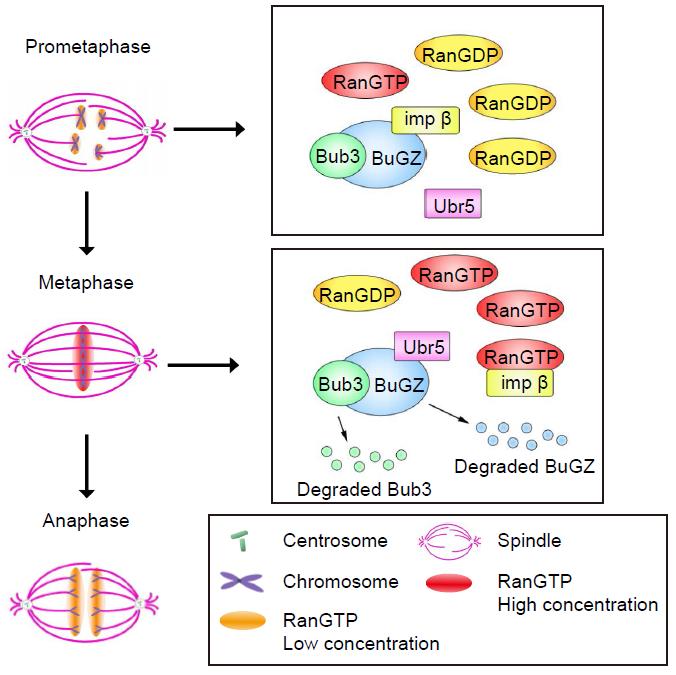
It is generally believed that during mitosis, the spindle checkpoint is inactivated when all chromosomes have established bipolar microtubule-kinetochore attachment. However, cells linger for more than ten minutes in metaphase, suggesting existence of additional monitoring system(s). RanGTP is suspected to sense full chromosome alignment independently of the canonical mechanism that monitors the status of microtubule-kinetochore attachment. The underlying molecular mechanism of this second monitoring system, however, is unclear.
JIANG Hao et al. from Institute of Biochemistry and Cell Biology, Shanghai Institutes for Biological Sciences, CAS, and Carnegie Institution for Science, USA, found that RanGTP promotes the turnover of BuGZ and Bub3 in metaphase, which in turn facilitates metaphase to anaphase transition.
Previous collaborative studies by the two labs of Dr. ZHU Xueliang and Dr. ZHENG Yixian identified BuGZ as a spindle matrix protein important for efficient and accurate mitosis by both stabilizing the spindle checkpoint protein Bub3 through direct interaction and promoting the end-on microtubule-kinetochore attachment (JIANG et al., Dev Cell, 2014).
Here Dr. JIANG and his colleagues further found that importin-b and an E3 ubiquitin ligase, Ubr5, compete for binding to BuGZ, whereas RanGTP sequesters importin-b and promotes the degradation of both BuGZ and Bub3 in an Ubr5-dependent manner. As the highest RanGTP concentration is known to emerge around metaphase chromosomes, their results suggest that the RanGTP-Ubr5-BuGZ-Bub3 axis serves as a double insurance to guarantee spindle checkpoint silencing only after full chromosome alignment.
This study, published by The Journal of Cell Biology on October 5th, 2015, was supported by National Natural Science Foundation of China, Ministry of Science and Technology of China, Chinese Academy of Sciences and NIH.

Figure. A model for RanGTP regulated anaphase entry mediated by Ubr5-induced BuGZ and Bub3 turnover in metaphase. (Image by Dr. ZHU Xueliang's research group)
CONTACT:
ZHU Xueliang, Principal Investigator
Institute of Biochemistry and Cell Biology, Shanghai Institutes for Biological Sciences, Chinese Academy of Sciences,
Shanghai 200031, China
Phone: 86-21-54921406
E-mail: xlzhu@sibcb.ac.cn

86-10-68597521 (day)
86-10-68597289 (night)

86-10-68511095 (day)
86-10-68512458 (night)

cas_en@cas.cn

52 Sanlihe Rd., Xicheng District,
Beijing, China (100864)

